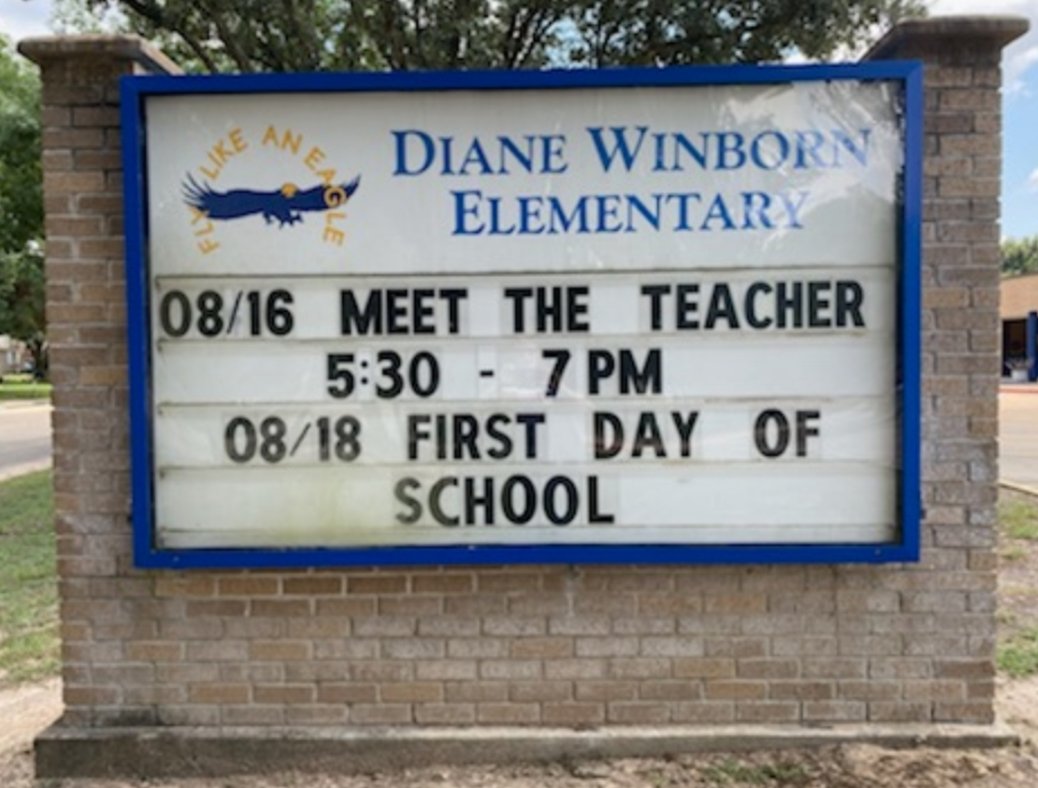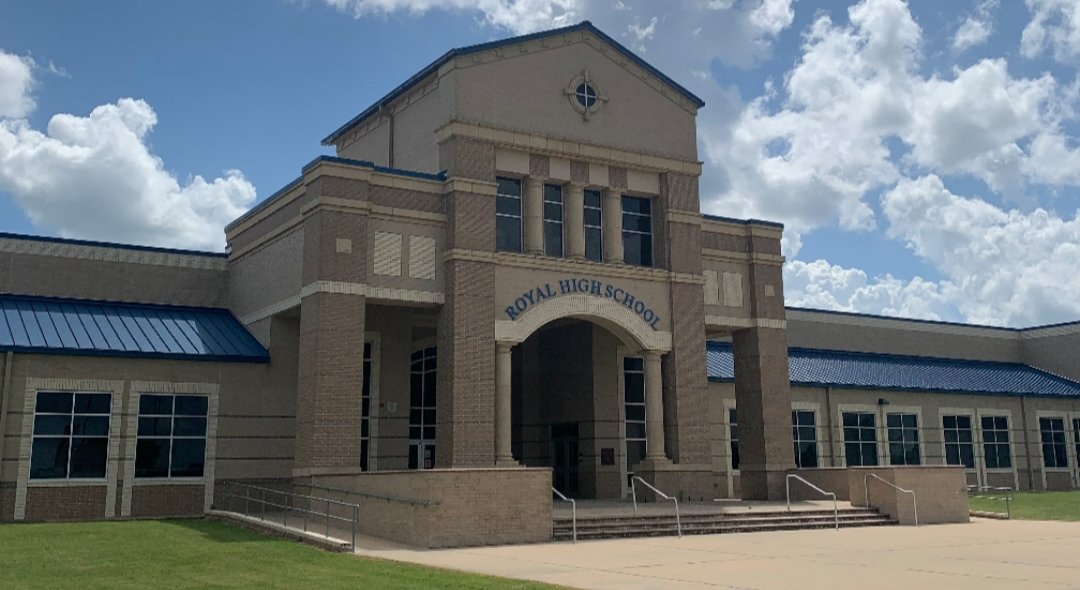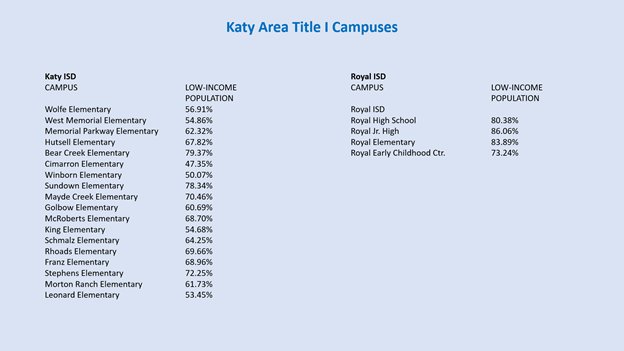Area school districts address Title I challenges amid pandemic
Title I schools are institutions that receive funding for additional educational resources for schools that have an increased number of students from low-income families. Both Royal and Katy ISDs …
This item is available in full to subscribers.
Attention subscribers
To continue reading, you will need to either log in to your subscriber account, or purchase a new subscription.
If you are a current print subscriber, you can set up a free website account and connect your subscription to it by clicking here.
If you are a digital subscriber with an active, online-only subscription then you already have an account here. Just reset your password if you've not yet logged in to your account on this new site.
Otherwise, click here to view your options for subscribing.
Please log in to continue |
Area school districts address Title I challenges amid pandemic
Title I schools are institutions that receive funding for additional educational resources for schools that have an increased number of students from low-income families. Both Royal and Katy ISDs work to implement programs in those schools to provide support to low-income students to ensure they are successful despite economic challenges.
According to a Texas Education Agency spokesperson, Title I, Part A of the Texas Education Code provides additional resources for schools with higher numbers of low-income students to ensure those students’ economic barriers to education are mitigated and to ensure the campus meets state performance standards.
The TEA provides different kinds of resources to Title I schools including material resources and services along with funding. Their resources include print resources, statewide training and technical assistance through the regional Education Service Centers, according to the agency’s website. Last school year the TEA distributed just under $1.5 million to Title I schools statewide.
Katy ISD
Forty percent of students from KISD Title I schools are economically disadvantaged, said KISD Director of Federal Programs and External Funding Nakia Coy. These schools complete a needs assessment to decide how funds will be spent through a campus improvement plan. The campus improvement plan includes reform strategies for the school as a whole, possible tutoring programs and a family engagement plan. KISD concentrates on giving funds to elementaries to help younger students, Coy said.
KISD uses its funding from the government on resources students need to succeed. Title I money goes toward books, teaching aids and technology to help students succeed. These funds are also used for professional development and to have more intervention teachers on hand, Coy said. Intervention teachers provide knowledge and support for students who have behavioral, social and educational challenges.
To keep parents engaged, the district focuses on communication by providing parents with materials to ensure they are aware of what is being taught to encourage them to engage with the schools.
“This effort is to support communication between home and school and help support education at home,'' said Coy.
The 2020-21 school year was a challenge due to virtual learning students had to endure during the pandemic. Students in KISD Title I campuses historically perform higher than students statewide in reading and math each year, Coy said.
While statewide data shows Katy students did slip, district students did continue to outperform districts statewide.
During the past academic school year “Katy ISD Title I students performed 5% higher than all students in the state in achieving the state standard for success on the reading STAAR test and 3% higher on the math STAAR test,” said Coy.
Royal ISD
Royal ISD has a total of four main campuses – of which all are designated Title 1.
RISD provides Title I resources for its students, said RISD Associate Superintendent Kendra Strange. The district has an early childhood center that consists of Pre-kindergarten to first grade, an elementary school that serves from second grade to fifth grade, a junior high school starting from 6th grade to 8th grade, and a high school starting from ninth grade to twelfth grade. There is also an early college high school within Royal High School.
RISD already used technology to educate their students, so when the pandemic kept students at home the schools were not rushing to find a way to teach students from their computers, Strange said. The biggest adjustment was finding a way for students to have access to technology at home. Royal students were allowed to use either their personal devices or check a computer out from the district. Pre-K students used iPads while other students use Chromebooks.
RISD focuses on teaching with the best instructional practices during the school day rather than through after-school programs, Coy said. However, the district does provide those programs when needed. Strange said the student-to-teacher ratio is below the state average which helps with the quality of instruction.
“We purposefully staff to be well below the state average for student-to-teacher ratio,” said Strange.
RISD receives state and federal funding, including State Compensatory Education funds. Federal grants have been released to the district through pandemic-based legislation. These grants are being used to help students recuperate from pandemic-based learning losses, Strange said.
RISD is working to add additional learning spaces. Their goal is to create a secure outdoor learning area for their students. This outdoor learning area will allow teachers to be able to teach students outside effectively and reduce the risk of having to go virtual because of improved social distancing. Keeping instruction in-person is anticipated to improve student outcomes, Strange said.
In the previous school year, the district saw a smaller drop in student test scores than the state average, said Strange. Their technological foundation helped them to not struggle as much academically.
RISD focuses on best instructional practices over programs for their students. They focus on the human element of education instead of relying on a specific program to be the solution to all concerns. Strange said RISD focuses on hiring high-quality educators to help all of the district’s students excel regardless of income.
“We believe that putting great teachers in front of our kids every single day is what makes a difference for our students,” said Strange.
Keywords
Katy ISD, Royal ISD, KISD, RISD, Title I











